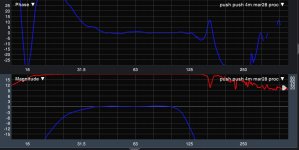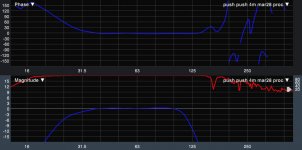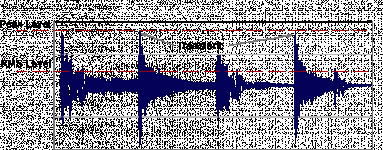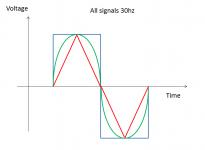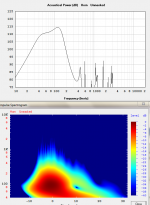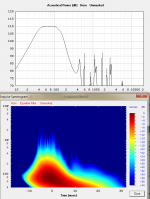Rule of thumb: GD(ms) < (0.8 / f) * 1000. (f in Hz) to be non audible. It is the in-room response that matters. But you're on a good start with a low Gd box...
Last edited:
Here's a dual 18 BR" with FIR processing.
Measurements were taken outdoors, 1/6 oct smoothing.
First one is group delay; second is phase to support the group delay trace.
If you can go the FIR route, group delay is pretty easily tamed imo.
Measurements were taken outdoors, 1/6 oct smoothing.
First one is group delay; second is phase to support the group delay trace.
If you can go the FIR route, group delay is pretty easily tamed imo.
Attachments
It reaches peak at some time but thats not the group delay. Group delay is the measure of phase change AT that frequency, not peak time of tone buildup.
...
whats your point?
My point was you asked for proof that a group-delay would result in later reaching steady state - which i meant is a 1:1 correlation.
But oops. I also thought the GD time is the peak before it reaches steady state, I checked, and youre right, im not

heres a steep minphase lowpass

thats the corresponding group delay
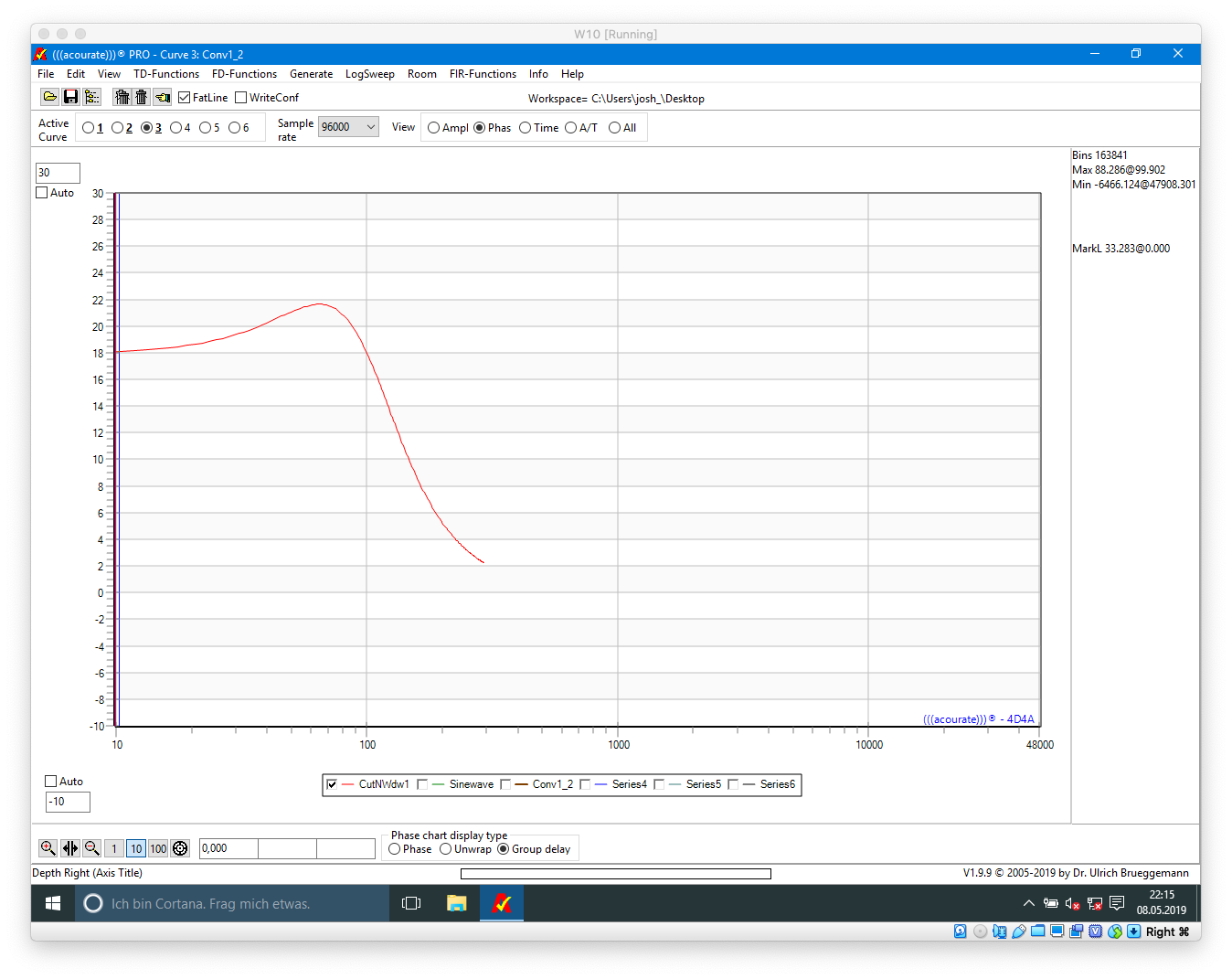
and its corresponding step response
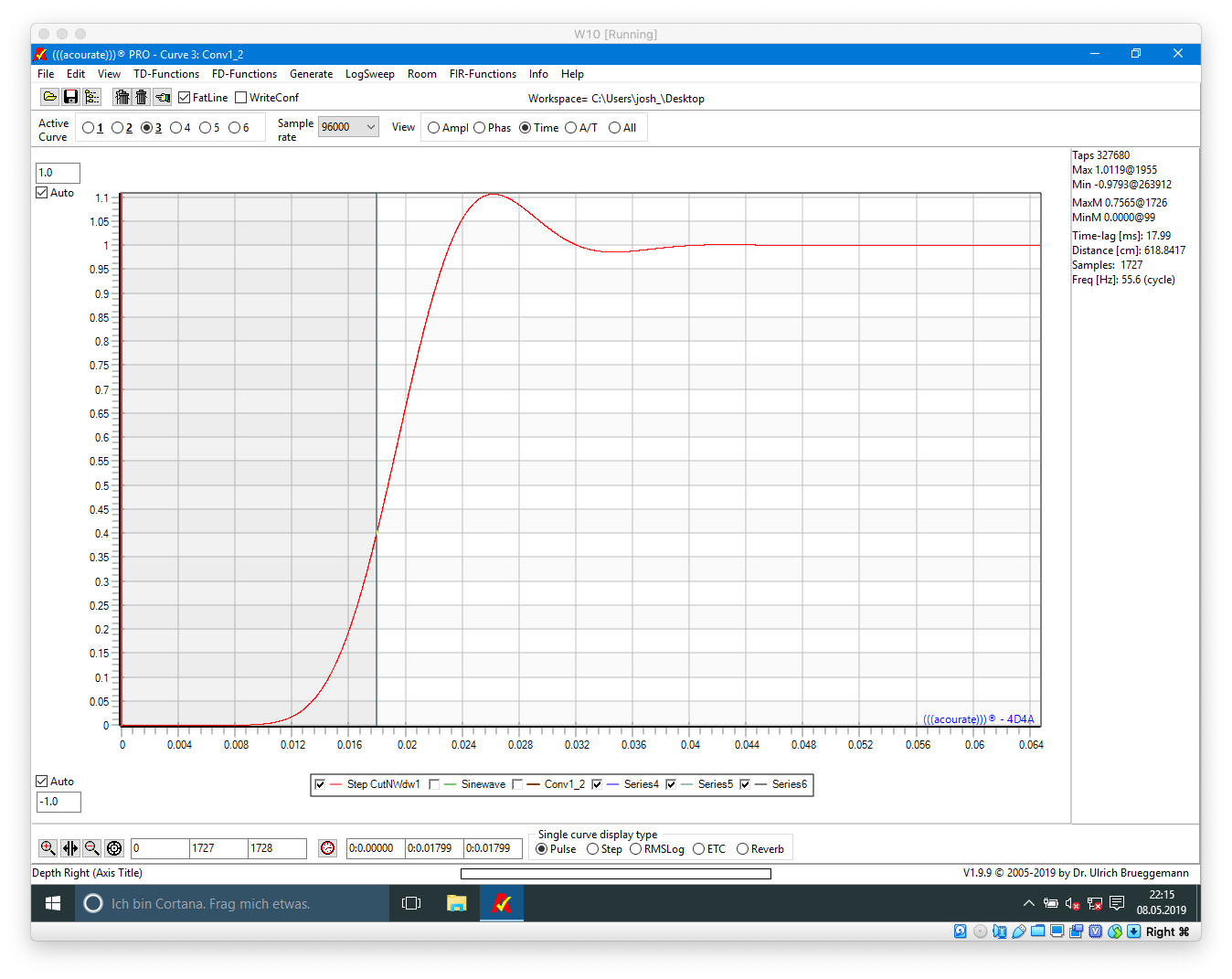
now getting to the point, a 100Hz sinewave (green) running through that lowpass (red) will look like that (thick brown):
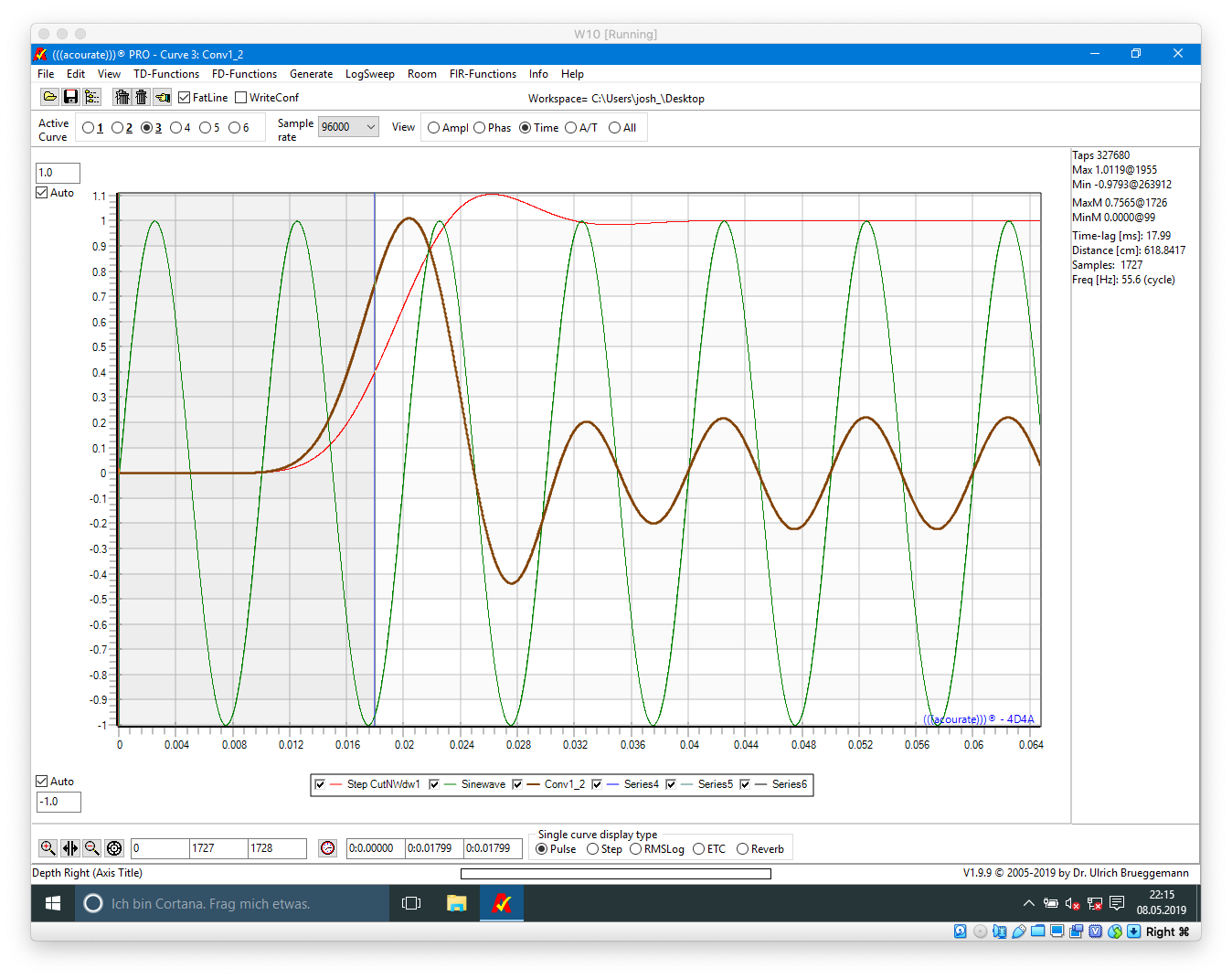
the blue line + gray left window is 18ms - time position, which relates to the group delays vertical offset. No correlation the the peak neither to steady state...
Im afraid I dont understand the group delay calculation myself 😀
I dont want to bring this off topic either but ... its kind of response-subwoofer-related I hope

Maybe you dont mind explaining me what you mean with phase-change? Obviously thats more than 1 period (360°) ....

cheers
Josh
Hi audfrknaveen,
Trying to make things simples, here is my 2 cents:
You can think about transient as the loudspeaker ability to proper translate voltage signal (from amplifier) to cone motion (drive + enclosure).
When we think about sine waves, it changes amplitude in a very smooth way, but what happen if the voltage signal changes it's amplitude really fast? in this case, think about drive cone acceleration and amplitude motion but not about frequency, so how can we compare transients only looking to delay chart? it won't give you the right answer, only part of it.
I don't have the proper answer for you but the indication below may help you:
Note: Some musics and instruments present more transients then others, like Circlomanen said, drums have a lot of transient, mainly at the beginning at the notes, it's also known that compressor are largely used to change signal dynamics but they will also change signal tones and fidelity, but as long as you are reproducing a recorded sound is better if your system is able to reproduce the signal in a high fidelity way but also take in mind that "high fidelity" doesn't mean that you will like the sound so in this case you can choose the design your ear like most.
Trying to make things simples, here is my 2 cents:
You can think about transient as the loudspeaker ability to proper translate voltage signal (from amplifier) to cone motion (drive + enclosure).
When we think about sine waves, it changes amplitude in a very smooth way, but what happen if the voltage signal changes it's amplitude really fast? in this case, think about drive cone acceleration and amplitude motion but not about frequency, so how can we compare transients only looking to delay chart? it won't give you the right answer, only part of it.
I don't have the proper answer for you but the indication below may help you:
- Drivers with high motor strength (BL) and light cones (mms) offer better acceleration (physic law: Force = Mass x Acceleration)
- Light cones will present higher distortion regarding desired SPL compared to heavy ones (stiffer)
- Sealed box are known to present better transient response and they are easy to tune (look for damper response)
- The best transient you can achieve will need a "closed loop" control loudspeaker, it means that you need a driver with sensor assembled on its cone and some electronics associated
Note: Some musics and instruments present more transients then others, like Circlomanen said, drums have a lot of transient, mainly at the beginning at the notes, it's also known that compressor are largely used to change signal dynamics but they will also change signal tones and fidelity, but as long as you are reproducing a recorded sound is better if your system is able to reproduce the signal in a high fidelity way but also take in mind that "high fidelity" doesn't mean that you will like the sound so in this case you can choose the design your ear like most.
Lordsansui:
Youre mixing up impulse steepness, transient response, and frequency response.
A lowpass must have a slow response.
If the voltage changes rapidly, its causing a high tone.
If the woofer runs with a lowpass, the transient will be „swallowed away“.
If it didnt, its not a woofer. Or the crossover is broken.
I do own a state of the art system with sealed box - best possible group delay. It has relatively small sized, light stiff cones. It does have a moving coil pickup on the cone, feeding a motion feedback system with processor control. Now there is no way to have more accelerated cone movement that follows better its required transient function.
You know how it sounds currently? Boomy 😀 thanks to the room of course.
Get on notching them out with DSP. Anything else is not interesting before you’ve done that. I know how that sounds too. Its not only different ballpark. Its whole different universe of pleasure!
Cheers
Josh
Youre mixing up impulse steepness, transient response, and frequency response.
A lowpass must have a slow response.
If the voltage changes rapidly, its causing a high tone.
If the woofer runs with a lowpass, the transient will be „swallowed away“.
If it didnt, its not a woofer. Or the crossover is broken.
I do own a state of the art system with sealed box - best possible group delay. It has relatively small sized, light stiff cones. It does have a moving coil pickup on the cone, feeding a motion feedback system with processor control. Now there is no way to have more accelerated cone movement that follows better its required transient function.
You know how it sounds currently? Boomy 😀 thanks to the room of course.
Get on notching them out with DSP. Anything else is not interesting before you’ve done that. I know how that sounds too. Its not only different ballpark. Its whole different universe of pleasure!
Cheers
Josh
I was just making things more simple, it's not my goal initiate a debate.
Transient means things that happen in a very shot time, so they use to be fast, what happen in a long time is a "steady state". If a drum skin is hitted, it will first produce a transient and after a "steady state" that you can recognize the tone and harmonics. (attachment #1)
I can't totally agree with that, you can say that high tone for sure will be there but not only, it may have a lot of waves summed even lower tunes.
To make things visible (attachment #2):
30Hz is low tune right? so a square wave of 30Hz produces high tune? it instantly rise in voltage. 30Hz of triangular wave will require less acceleration because compared to square it rise the voltage smoother, simple example with the same base frequency requiring different dynamics.
Look for PID controller then you will find some answers about change system dynamics making it faster, mainly if work on the derivative part, the side effect might be overshot, someone need to make his own trade-off.
Transient means things that happen in a very shot time, so they use to be fast, what happen in a long time is a "steady state". If a drum skin is hitted, it will first produce a transient and after a "steady state" that you can recognize the tone and harmonics. (attachment #1)
If the voltage changes rapidly, its causing a high tone.
I can't totally agree with that, you can say that high tone for sure will be there but not only, it may have a lot of waves summed even lower tunes.
To make things visible (attachment #2):
30Hz is low tune right? so a square wave of 30Hz produces high tune? it instantly rise in voltage. 30Hz of triangular wave will require less acceleration because compared to square it rise the voltage smoother, simple example with the same base frequency requiring different dynamics.
Look for PID controller then you will find some answers about change system dynamics making it faster, mainly if work on the derivative part, the side effect might be overshot, someone need to make his own trade-off.
Attachments
Last edited:
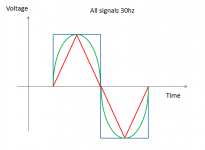
Thank you LORDSANSUI for posting this picture!
It is a great example of nonlinear signals (not made up of any numbers of sine waves )
Music is mainly nonlinear and percussive instruments like drums are maybe the best example of this nonlinearity. The transient response discussed in this thread is mainly the bass loudspeakers ability to reproduce nonlinear signals (not made up of sine waves) and the transient initial displacement peak of a percussive instrument or a plucked bass guitar string is very far from a linear sine wave based signal. A bass reflex box will through its steep high Q low pass filter function of the port try to "sinewaveify" everything fed through it. It is a sine wave oscillator lagging at least one wavelength behind the main signal at steady state signals and with a several wavelengths long build-up time to reach full amplitude.
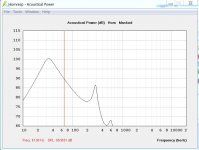
This is the port response of a B&C 15TBX100 in a 32 Hz tuned 120 liter BR.
It is 10 dB down at approximately 19 Hz and 66 Hz.. Almost two full octaves within 10 dB.
This strongly indicates that the high Q sine wave producing port will effect every signal between 19 and 66 Hz. A BR port is unable to reproduce nonlinear non-sinusoidal waveforms and will effect the perceived transient and dynamic character of drums, plucked bass guitar strings etc...
It will turn it into a droning resonant sine wave noise detached from the original signal in both reproduced wave shape and in the time-domain.
A horn, tapped horn or high order quarter wave based bandpass will reproduce nonlinear non-sinusoidal much better then any Helmholtz-based enclosure. It is quite common knowledge that Helmholtz-based bandpass enclosures lacks the transient abilities of a front-loaded horn. A bass reflex box is partly "saved" by the direct radiation from the driver. At least compared to a true Helmholtz-based bandpass box.
Last edited:
The transient response applies to the speaker system not just the woofer, try disconnecting the tweeter and/or midrange from a speaker system that produces an otherwise "perfect" transient response and hear what happens. The woofer usually has a low pass electrical filter in-front of it, it and the enclosure are mechanical filters.The transient response discussed in this thread is mainly the bass loudspeakers ability to reproduce nonlinear signals (not made up of sine waves) and the transient initial displacement peak of a percussive instrument or a plucked bass guitar string is very far from a linear sine wave based signal.
It is a great example of nonlinear signals (not made up of any numbers of sine waves )
Music is mainly nonlinear and percussive instruments like drums are maybe the best example of this nonlinearity.
Music has sine waves. An FFT will show all the sine components of music sample. A square wave has lots of sine waves and so does a triangular wave. One has to just see in the frequency domain.
This image shows how sine waves add up to result a square wave.
https://i.stack.imgur.com/6yngK.gif. In the image the square wave is not perfect because not enough sine waves are summed, its a simple example after all.
Take another example, MP3 compression, where the music is represented in sinewaves and stored so that equations and formulas that generate (synthesize) sine waves can reproduce the same original music later.
And also sine wave superimposition is linear.
Last edited:
It is quite common knowledge that Helmholtz-based bandpass enclosures lacks the transient abilities of a front-loaded horn. A bass reflex box is partly "saved" by the direct radiation from the driver. At least compared to a true Helmholtz-based bandpass box.
Well, I cant comment on horn but the phase rotation of ported/bandpass can be corrected by reverse phase rotation, either in DSP or active analog.
Maybe you dont mind explaining me what you mean with phase-change? Obviously thats more than 1 period (360°) ....
GD is another way of describing the phase change at a particular frequency. 0 degrees phase change has 0 GD.
When it comes to the analysis of asymmetrical waves, which I suspect is what Circlomanen means by non-linear (I'm not sure what he means?) all that has to be considered is the time element of the individual component sines. It seems to me he sees a problem where there isn't one?
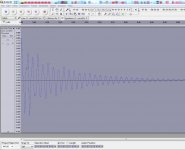
When playing this 50 Hz centered Risset drum generated with Audacity through my H-ROAR crossed over LP @ 120 Hz 48 dB/octave I can clearly hear a sharp but somewhat muffled transient. A 50 Hz sine wave started suddenly (no gradual buildup) sounds totally different.
There is a very obvious difference between a sharp transient reproduced by a steep LP filtered bandwidth limited H-ROAR and the same played though a bass reflex box. Through the BR it easy to hear the resonant decay from the port superimposed on the decaying signal fed to the driver. And the initial transient is more muffled and dull through the bass reflex.
Last edited:
When it comes to the analysis of asymmetrical waves, which I suspect is what Circlomanen means by non-linear
all that has to be considered is the time element of the individual component sines
Musical acoustics
The physical behavior of musical acoustics is mainly nonlinear. Many attempts are made to model their sound generation from physical modeling of emulating their sound from measurements of their non-linearity.[7]
Nonlinear acoustics (NLA) is a branch of physics and acoustics dealing with sound waves of sufficiently large amplitudes. Large amplitudes require using full systems of governing equations of fluid dynamics (for sound waves in liquids and gases) and elasticity (for sound waves in solids). These equations are generally nonlinear, and their traditional linearization is no longer possible.
Nonlinear acoustics - Wikipedia
Last edited:

Nonlinear Acoustics and Acoustic Chaos | SpringerLink
Why is not Fourier Transform Good for Non-linear Processes - Signal Processing Stack Exchange
FFT is not very useful on nonlinear signals such as music from real life instruments. Sure you can get an approximation of the harmonic content, but it is only a crude approximation.
Music is not composed of simple or complex sets of sine waves. IF you have an infinite bandwidth (few amps or speakers can even play a slow 100 megahertz signal) then you can compose a square wave from an infinite set of sine waves.
Last edited:
Why is not Fourier Transform Good for Non-linear Processes - Signal Processing Stack Exchange[/url]
FFT is not very useful on nonlinear signals such as music from real life instruments. Sure you can get an approximation of the harmonic content, but it is only a crude approximation.
Can we not hear MP3 encoded drum?
Those resonnance / decay you talking about are nothing compared to real life natural in room resonnances.
And as you use hornresp, try spectrogram tool on your design...
Got a example on hand.
Here a bandpass spectrogram, for which hornresp calcul screen don't take account stuffing stuffing effect in picture 1 arround 150hz. But we can simply add a electric low pass, and see what happen in picture 2.
You can see, less "decay". Different filter slope (active/passive/acoustic filter...) lead to different damping.
Curve is not straight because of "group delay" but at frequency for which one cycle is long time, and so, ear needs not only one cycle to reconnize it, so overall, it just doesn't make real difference.
About reflex, you have to take whole system : Port + direct radiator, because they somewhat damp each others by nulling effects dues to phase.
And as you use hornresp, try spectrogram tool on your design...
Got a example on hand.
Here a bandpass spectrogram, for which hornresp calcul screen don't take account stuffing stuffing effect in picture 1 arround 150hz. But we can simply add a electric low pass, and see what happen in picture 2.
You can see, less "decay". Different filter slope (active/passive/acoustic filter...) lead to different damping.
Curve is not straight because of "group delay" but at frequency for which one cycle is long time, and so, ear needs not only one cycle to reconnize it, so overall, it just doesn't make real difference.
About reflex, you have to take whole system : Port + direct radiator, because they somewhat damp each others by nulling effects dues to phase.
Attachments
Can we not hear MP3 encoded drum?
Sure, but use a high quality uncompressed 24 bit 192 Khz recording (BIS records have good source material) and compress it down to a 256 Kbit MP3 and compare on a good FLH bass horn/Synergy top horn - system.
If you compare with heavily compressed modern rock or pop recordings then the difference might not be that large due to all the destructive post recording processing.
GD is another way of describing the phase change at a particular frequency. 0 degrees phase change has 0 GD.
Wonderfulaudio: i have asked you how the delay connects to the graph. Since you do not reply, explain, but give again empty misleading statement i suppose you may not have understood it yourself? 😀
Well, I cant comment on horn but the phase rotation of ported/bandpass can be corrected by reverse phase rotation, either in DSP or active analog.
Thats not true.
The time from 0 till peak and steady state is still same duration. With or without phase inversion.
You just let the sub play earlier, and pray not to hear prering.
- Status
- Not open for further replies.
- Home
- Loudspeakers
- Subwoofers
- Ported sub with good transient response
